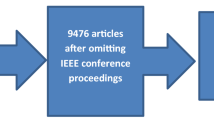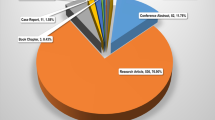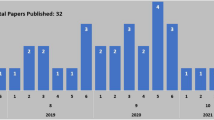Abstract
Snub publishing is a new term that was coined in 2013 to describe a range of publishing cases in which the failure of quality control manifested itself through references in such a way that it would cause unintended damage to snubbed scientists whose names or identity were incorrectly represented in the literature. In this paper, real case studies are presented, mostly related to the author as a “victim” of incompetent editorial oversight, inexperienced or biased authors, or as a “victim” of direct professional conflicts of interest. In essence, this paper serves as a prototype showing in concrete terms how a scientist can or may be professionally snubbed (intentionally or unintentionally). Using the Anthurium literature, this paper aims to raise awareness about snub publishing and seeks to encourage other scientists to also quantify how they too may have been professionally snubbed in the literature.


























Similar content being viewed by others
References
Teixeira da Silva JA. Snub publishing: theory. Asian Australas J Plant Sci Biotechnol. 2013;7(Special Issue 1):35–7.
Teixeira da Silva JA, Murasei F, Tanaka M. Growth vessel and substrate affect Anthurium micropropagation. Plant Tissue Cult. 2005;15(1):1–6.
Viégas J, da Rocha MTR, Ferreira-Moura I, Corrêa MGS, da Silva JB, dos Santos NC, Teixeira da Silva JA. Anthurium andraeanum (Linden ex André) culture: in vitro and ex vitro. Floriculture and ornamental. Biotechnology. 2007;1(1):61–5.
Winarto B, Mattjik NA, Teixeira da Silva JA, Purwito A, Marwoto B. Ploidy screening of anthurium (Anthurium andreanum Linden ex André) regenerants derived from anther culture. Sci Hortic. 2010;127:86–90.
Winarto B, Rachmawati F, Pramanik D, Teixeira da Silva JA. Morphological and cytological diversity of regenerants derived from anthurium anther culture. Plant Cell Tissue Organ Cult. 2011;105(3):363–74.
Winarto B, Rachmawati F, Teixeira da Silva JA. New basal media for half-anther culture of Anthurium andreanum Linden ex André cv. Tropical. Plant Growth Regul. 2011;65(3):513–29.
Winarto B, Teixeira da Silva JA. Influence of isolation technique of half-anthers and of initiation culture medium on callus induction and regeneration in Anthurium andreanum. Plant Cell Tissue Organ Cult. 2012;110(3):401–11.
Atak Ç, Çelik Ö. Micropropagation of Anthurium spp. In: Plant science. Intech, Croatia; 2012. p. 241–54.
Raad MK, Zanjani SB, Shoor M, Hamidoghli Y, Sayyad AR, Kharabian-Masouleh A, Kaviani B. Callus induction and organogenesis capacity from lamina and petiole explants of Anthurium andreanum Linden (Casino and Antadra). Aust J Crop Sci. 2012;6(5):928–37.
Gantait S, Sinniah UR, Mandal N, Das PK. Direct induction of protocorm-like bodies from shoot tips, plantlet formation, and clonal fidelity analysis in Anthurium andreanum cv. CanCan. Plant Growth Regul. 2012;67:257–70.
Farsi M, Taghavizadeh Yazdi ME, Qasemiomran V. Micropropagation of Anthurium andreanum cv. Terra. Afr J Biotechnol. 2012;11(68):13162–6.
Pinto de Carvalho ACP, Pinheiro MVM, Martins FB, Ferreira da Cruz FC, Otoni WC. Produção de mudas micropropagadas de antúrio (Anthurium andraeanum) cv. Eidibel por embriogênese somática. Embrapa Circ Técnica (Fortaleza). 2012;41:1–14.
Ancy D, Bopaiah AK, Reddy JM. In vitro seed culture studies in Anthurium bicolor (Agnihothri). Int J Integr Sci Innov Technol. 2012;1(4):16–20.
Bliss BJ, Suzuki JY. Genome size in Anthurium evaluated in the context of karyotypes and phenotypes. AoB Plants pls006; 2012.
Reddy JM, Bopaiah AK. Studies on the intiation [sic] of callusing and regeneration of plantlets in three different basal media with varied plant growth regulators for the micropropagation of Anthurium scherzeriaum [sic] using leaf and spathe as explants. Afr J Biotechnol. 2012;11(23):6259–68.
Sedaghati B, Babaeiyan N-A, Bagheri N-A, Salehiyan H, Khademian R. Effect of type and concentration of growth regulators on plant regeneration of Anthurium andraeanum. Int J Agric Res Rev. 2012;2(S):998–1004.
Gantait S, Sinniah UR. Morphology, flow cytometry and molecular assessment of ex-vitro grown micropropagated anthurium in comparison with seed germinated plants. Afr J Biotechnol. 2012;10(64):13991–1399867.
Kumari S, Desai JR, Shah RR. Callus mediated plant regeneration of two cut flower cultivars of Anthurium andraeanum Hort. J Appl Hortic. 2011;13(1):37–41.
Gantait S, Mandal N. Tissue culture of Anthurium andreanum: a significant review and future prospective. Int J Botany. 2010;6(3):207–19.
Harb EM, Talaat NB, Weheeda BM, El-Shamy M, Omira GA. Micropropagation of Anthurium andreanum from shoot tip explants. J Appl Sci Res. 2010;6(8):927–31.
Islam SA, Dewan MMR, Mukul MHR, Hossen MA, Khatun F. In vitro regeneration of Anthurium andreanum cv. Nitta. Bangladesh J Agric Res. 2010;35(2):217–26.
Atak Ç, Çelik Ö. Micropropagation of Anthurium andraeanum from leaf explants. Pak J Bot. 2009;41(3):1155–61.
Jahan MT, Islam MR, Khan R, Mamun ANK, Ahmed G, Hakim L. In vitro clonal propagation of anthurium (Anthurium andraeanum L.) using callus culture. Plant Tissue Cult Biotechnol. 2009;19(1):61–9.
Kurnianingsih R, Marfuah, Matondang I. Pengaruh pemberian bap (6-benzyl amino purine) pada media multiplikasi tunas Anthurium hookerii Kunth. Enum. secara in vitro. Vis Vitalis. 2009;2(2):23–30 (in Indonesian with English abstract).
Liendo M, Mogollón N. Multiplicación clonal in vitro del anturio (Anthurium andraeanum Lindl. cv. Nicoya). Bioagro. 2009;21(3):179–82 (in Spanish with English abstract).
Yu YX, Liu L, Liu JX, Wang J. Plant regeneration by callus-mediated protocorm-like body induction of Anthurium andraeanum Hort. Agric Sci China. 2009;8(5):572–7.
Bejoy M, Sumitha VR, Anish NP. Foliar regeneration in Anthurium andreanum Hort. cv. Agnihothri. Biotechnology (Pakistan). 2008;7(1):134–8.
Beyramizade E, Azadi P, Mii M. Optimization of factors affecting organogenesis and somatic embryogenesis of Anthurium andreanum Lind. Tera. Propag Ornam Plants. 2008;8:198–203.
Gantait S, Mandal N, Bhattacharyya S, Das PK. In vitro mass multiplication with pure genetic identity in Anthurium andreanum Lind. Plant Tissue Cult Biotechnol. 2008;18(2):113–22.
del Rivero-Bautista N, Agramonte-Peñalver D, Barbón-Rodríguez R, Camacho-Chiu W, Collado-López R, Jiménez-Terry F, Pérez-Peralta M, Gutiérrez-Martínez O. Somatic embryogenesis in (Anthurium andraeanum Lind.) variety ‘Lambada’. Ra Ximhai. 2008;4(1):135–49 (in Spanish with English abstract).
Lima FC, Ulisses C, Camara TR, Cavalcante UMT, Albuquerque CC, Willadino L. Anthurium andraeanum Lindl. cv. Eidibel in vitro rooting and acclimation with arbuscular mycorrhizal fungi. Revista Brasileira de Ciências Agrarias (Recife). 2006;1:13–6.
Nhut DT, Duy N, Vy NNH, Khue CD, Khiem DV, Vinh DN. Impact of Anthurium spp. genotype on callus induction derived from leaf explants, shoot and root regeneration capacity from callus. J Appl Hortic. 2006;8(2):135–7.
Te-chato S, Susanon T, Sontikun Y. Cultivar, explant type and culture medium influencing embryogenesis and organogenesis in Anthurium spp. Songklanakarin J Sci Technol. 2006;28(4):717–22.
Teixeira da Silva JA. Responsibilities and rights of authors, peer reviewers, editors and publishers: a status quo inquiry and assessment. Asian Australas J Plant Sci Biotechnol. 2013;7(Special Issue 1):6–15.
Teixeira da Silva JA. Predatory publishing: a quantitative assessment, the predatory score. Asian Australas J Plant Sci Biotechnol. 2013;7(Special Issue 1):21–34.
Teixeira da Silva JA. How to better achieve integrity in science publishing. Eur Sci Ed. 2013;39(4):97-8.
Raad MK, Zanjani SB, Sayyad AR, Maghsudi M, Kaviani B. Effect of cultivar, type and age of explants, light conditions and plant growth regulators on callus formation of anthurium. Am–Eurasian J Agric Environ Sci. 2012;12(6):706–12.
Beyramizade E, Azadi P. Effect of growth regulators on shoot formation of Anthurium andreanum Lind. Tera. Pajouhesh & Sazandegi. 2008;76:179–84 (in Farsi with English abstract).
Teixeira da Silva JA. The need for post-publication peer review in plant science publishing. Frontiers Plant Sci. 2013;4:485.
Author information
Authors and Affiliations
Corresponding author
Rights and permissions
About this article
Cite this article
Teixeira da Silva, J.A. Snub Publishing: Evidence from the Anthurium Literature. Pub Res Q 30, 166–178 (2014). https://doi.org/10.1007/s12109-014-9355-6
Published:
Issue Date:
DOI: https://doi.org/10.1007/s12109-014-9355-6




